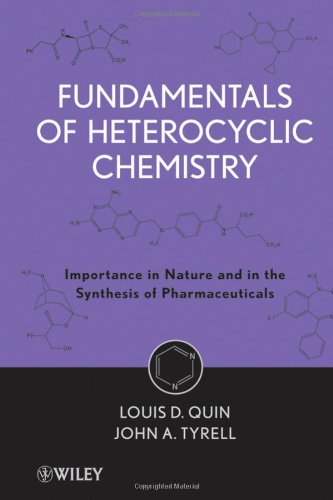

Most ebook files are in PDF format, so you can easily read them using various software such as Foxit Reader or directly on the Google Chrome browser.
Some ebook files are released by publishers in other formats such as .awz, .mobi, .epub, .fb2, etc. You may need to install specific software to read these formats on mobile/PC, such as Calibre.
Please read the tutorial at this link. https://ebooknice.com/page/post?id=faq
We offer FREE conversion to the popular formats you request; however, this may take some time. Therefore, right after payment, please email us, and we will try to provide the service as quickly as possible.
For some exceptional file formats or broken links (if any), please refrain from opening any disputes. Instead, email us first, and we will try to assist within a maximum of 6 hours.
EbookNice Team

Status:
Available4.6
24 reviews
ISBN 10: 0470566698
ISBN 13: 9780470566695
Author: Louis D Quin, John Tyrell
Heterocyclic chemistry is of prime importance as a sub-discipline of Organic Chemistry, as millions of heterocyclic compounds are known with more being synthesized regularly Introduces students to heterocyclic chemistry and synthesis with practical examples of applied methodology Emphasizes natural product and pharmaceutical applications Provides graduate students and researchers in the pharmaceutical and related sciences with a background in the field Includes problem sets with several chapters
Chapter 1 THE SCOPE OF THE FIELD OF HETEROCYCLIC CHEMISTRY.
References.
Appendix.
Chapter 2 COMMON RING SYSTEMS AND THE NAMING OF HETEROCYCLIC COMPOUNDS.
2.1. General.
2.2. Naming Simple Monocyclic Compounds.
2.3. Handling the "Extra Hydrogen".
2.4. Substituted Monocyclic Compounds.
2.5. Rings With More Than One Heteroatom.
2.6. Bicyclic Compounds.
2.7. Multicyclic Systems.
2.8. The Replacement Nomenclature System.
2.9. Saturated Bridged Ring Systems.
References.
Review Exercises.
Chapter 3 NATURE AS A SOURCE OF HETEROCYCLIC COMPOUNDS.
3.1. General.
3.2. Naturally Occurring Nitrogen Heterocyclic Compounds.
3.3. Oxygen Compounds.
3.4. Sulfur and Phosphorus Heterocyclic Compounds in Nature.
References.
Chapter 4 PRINCIPLES OF SYNTHESIS OF AROMATIC HETEROCYCLES BY INTRAMOLECULAR CYCLIZATION.
4.1. General.
4.2. Some of the Classic Synthetic Methods.
4.3. Cyclizations Involving Metallic Complexes as Catalysts.
4.4. Cyclizations with Radical Intermediates.
4.5. Cyclizations by Intramolecular Wittig Reactions.
4.6. Synthesis of Heterocycles by the Alkene Metathesis Reaction.
References.
Review Exercises.
Chapter 5 SYNTHESIS OF HETEROCYCLIC SYSTEMS BY CYCLOADDITION REACTIONS.
5.1. The Diels–Alder Reaction.
5.2. Dipolar Cycloadditions.
5.3. [2 + 2] Cycloadditions.
References.
Review Exercises.
Chapter 6 AROMATICITY AND OTHER SPECIAL PROPERTIES OF HETEROCYCLES: PI-DEFICIENT RING SYSTEMS.
6.1. General.
6.2. Review of the Aromaticity of Benzene.
6.3. Pi-Deficient Aromatic Heterocycles.
References.
Review Exercises.
Chapter 7 AROMATICITY AND OTHER SPECIAL PROPERTIES OF HETEROCYCLES: PI-EXCESSIVE RING SYSTEMS AND MESOIONIC RING SYSTEMS.
7.1. Pi-Excessive Aromatic Heterocycles.
7.2. Mesoionic Heterocycles.
References.
Review Exercises.
Chapter 8 THE IMPORTANCE OF HETEROCYCLES IN MEDICINE.
8.1. General.
8.2. Historical.
8.3. Pyridines.
8.4. Indoles.
8.5. Quinolines.
8.6. Azepines.
8.7. Pyrimidines.
8.8. Concluding Remarks.
References.
Chapter 9 SYNTHETIC METHODS FOR SOME PROMINENT HETEROCYCLIC FAMILIES: EXAMPLES OF PHARMACEUTICALS SYNTHESIS.
9.1. Scope of the Chapter.
9.2. Pyrroles.
9.3. Furans.
9.4. Thiophenes.
9.5. 1,3-Thiazoles.
9.6. 1,3-Oxazoles.
9.7. Imidazoles.
9.8. Pyrazoles.
9.9. 1,2,4-Triazoles.
9.10. Tetrazoles.
9.11. 1,3,4-Thiadiazoles and other 5-Membered Systems.
9.12. Indole.
9.13. Pyridines.
9.14. Quinolines and Isoquinolines.
9.15. Benzodiazepines.
9.16. Pyrimidines.
9.17. Fused Pyrimidines: Purines and Pteridines.
9.18. 1,3,5-Triazines.
9.19. Multicyclic Compounds.
References.
Review Exercises.
Chapter 10 GEOMETRIC AND STEREOCHEMICAL ASPECTS OF NONAROMATIC HETEROCYCLES.
10.1. General.
10.2. Special Properties of Three-Membered Rings.
10.3. Closing Heterocyclic Rings: Baldwin’s Rules.
10.4. Conformations of Heterocyclic Rings.
10.5. Chirality Effects on Biological Properties of Heterocycles.
References.
Review Exercises.
Chapter 11 SYNTHETIC HETEROCYCLIC COMPOUNDS IN AGRICULTURAL AND OTHER APPLICATIONS.
11.1. Heterocyclic Agrochemicals.
11.2. Applications of Heterocyclic Compounds in Commercial Fields.
References.
Appendix UNIFIED AROMATICITY INDICES (IA) OF BIRD.
INDEX.
fundamentals of heterocyclic chemistry
fundamentals of heterocyclic chemistry pdf
essentials of heterocyclic chemistry-ii
heterocyclic chemistry lecture
heterocyclic pdf
basic heterocyclic compounds
Tags: Louis D Quin, John Tyrell, Fundamentals, Heterocyclic